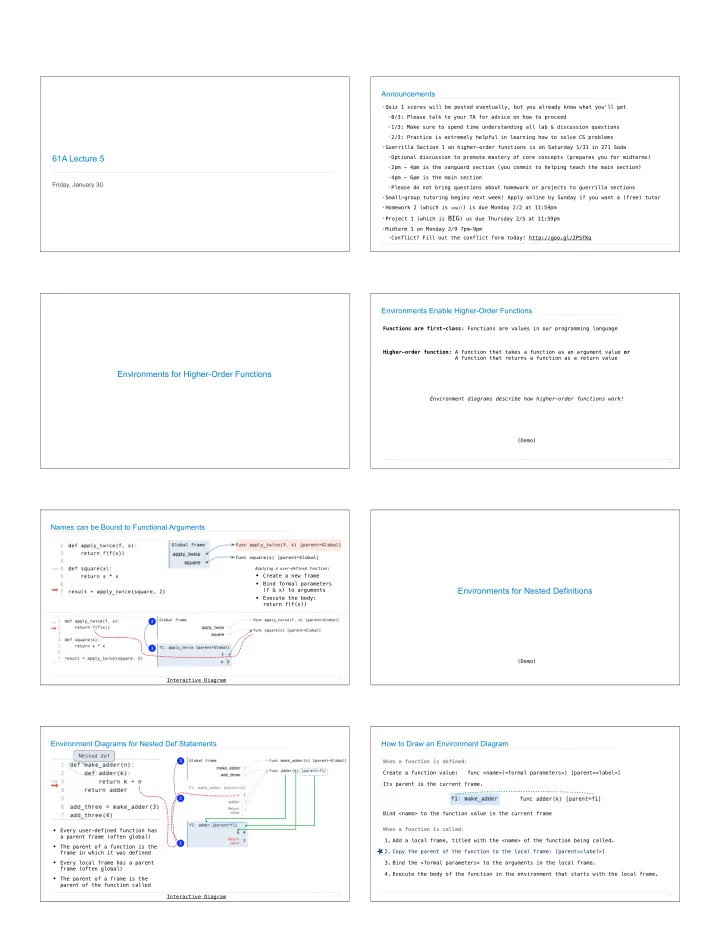

Announcements • Quiz 1 scores will be posted eventually, but you already know what you'll get § 0/3: Please talk to your TA for advice on how to proceed § 1/3: Make sure to spend time understanding all lab & discussion questions § 2/3: Practice is extremely helpful in learning how to solve CS problems • Guerrilla Section 1 on higher-order functions is on Saturday 1/31 in 271 Soda 61A Lecture 5 § Optional discussion to promote mastery of core concepts (prepares you for midterms) § 2pm - 4pm is the vanguard section (you commit to helping teach the main section) § 4pm - 6pm is the main section Friday, January 30 § Please do not bring questions about homework or projects to guerrilla sections • Small-group tutoring begins next week! Apply online by Sunday if you want a (free) tutor • Homework 2 (which is small ) is due Monday 2/2 at 11:59pm • Project 1 (which is BIG ) us due Thursday 2/5 at 11:59pm • Midterm 1 on Monday 2/9 7pm-9pm § Conflict? Fill out the conflict form today! http://goo.gl/2P5fKq 2 Environments Enable Higher-Order Functions Functions are first-class: Functions are values in our programming language Higher-order function: A function that takes a function as an argument value or A function that returns a function as a return value Environments for Higher-Order Functions Environment diagrams describe how higher-order functions work! (Demo) 4 Names can be Bound to Functional Arguments Applying a user-defined function: • Create a new frame • Bind formal parameters (f & x) to arguments Environments for Nested Definitions • Execute the body: return f(f(x)) 2 1 (Demo) Interactive Diagram 5 Environment Diagrams for Nested Def Statements How to Draw an Environment Diagram Nested def 3 When a function is defined: Create a function value: func <name>(<formal parameters>) [parent=<label>] Its parent is the current frame. 2 Bind <name> to the function value in the current frame • Every user-defined function has When a function is called: a parent frame (often global) 1. Add a local frame, titled with the <name> of the function being called. 1 • The parent of a function is the 2. Copy the parent of the function to the local frame: [parent=<label>] frame in which it was defined • Every local frame has a parent 3. Bind the <formal parameters> to the arguments in the local frame. frame (often global) 4. Execute the body of the function in the environment that starts with the local frame. • The parent of a frame is the parent of the function called Interactive Diagram 7 8
Local Names are not Visible to Other (Non-Nested) Functions “y” is not found, again Error 2 Local Names 1 “y” is not found • An environment is a sequence of frames. • The environment created by calling a top-level function (no def within def) (Demo) consists of one local frame, followed by the global frame. Interactive Diagram 10 The Environment Diagram for Function Composition 3 3 2 Function Composition 2 1 Return value of make_adder is an argument to compose1 (Demo) 1 Interactive Diagram 12 Lambda Expressions An expression: this one >>> x = 10 evaluates to a number >>> square = x * x Also an expression: evaluates to a function Lambda Expressions >>> square = lambda x: x * x Important: No "return" keyword! A function with formal parameter x that returns the value of "x * x" >>> square(4) 16 Must be a single expression Lambda expressions are not common in Python, but important in general (Demo) Lambda expressions in Python cannot contain statements at all! 14 Lambda Expressions Versus Def Statements VS def square(x): square = lambda x: x * x return x * x • Both create a function with the same domain, range, and behavior. • Both functions have as their parent the frame in which they were defined. Currying • Both bind that function to the name square. • Only the def statement gives the function an intrinsic name. The Greek letter lambda 15
Function Currying def make_adder(n): return lambda k: n + k >>> make_adder(2)(3) There's a general 5 relationship between (Demo) >>> add(2, 3) these functions 5 Curry : Transform a multi-argument function into a single-argument, higher-order function 17
Recommend
More recommend